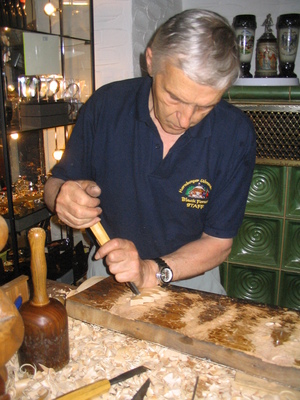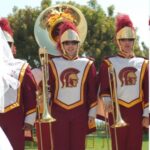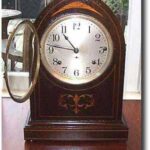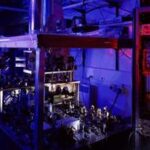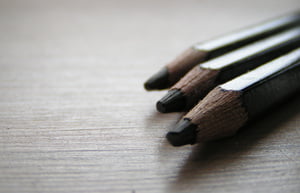Imagine pondering waterwheel or flower garden, wood cutter or marching band, tumbling kids or animals frolicking in a meadow… after weighing the comparative beauty of a vast display of cuckoo clocks, you choose the perfect specimen for your wall. Then, upon eagerly unwrapping and installing it, and waiting for the minute hand to reach twelve, you hear the little birdie say “Beep! Beep!,” roadrunner style.
“Beep, beep?”
That Warner Brothers pest is a member of the cuckoo family? He sure is. But, no, we never encountered a roadrunner cuckoo clock in the Black Forest of Germany. And we didn’t find clocks crowing “Cock-a-doodle-doo,” either, despite the fact that rooster clocks were the presumptive forbears of the cuckoo clock. What we did find was hundreds of styles of clocks with intricate, hand-carved accents, chirping exclusively “Cuckoo” on the hour.
Brushing Up on the History of Black Forest Cuckoo-Clock-Making
The Black Forest is a heavily-forested area along the Rhine in southwestern Germany, close to the borders of both France and Switzerland. While the name Black Forest invokes fears of some long-ago criminal rampage, it actually derives from the appearance of the land with the canopies of massive numbers of trees blocking the sunlight. Pines and firs dominate the landscape. Naturally, with the ready availability of wood, a community of woodcarvers evolved there.
Clock-making began in 1630 in Germany’s Black Forest region. In about 1738 Franz Ketterer, probably influenced by Czech craftsmen who made intricate wood-carved clocks with roosters crowing the hour, created the first cuckoo clock. The change from rooster to cuckoo was most likely motivated by the facility of creating a cuckoo sound, an easier sound to reproduce than the trill of the rooster. These charming clocks with cuckoos peeking out of doors to announce the hour instantly became popular and remain a mainstay of the Black Forest’s economy today.
Cuckoo clock construction is an art passed down through generations. The work is still done by hand from the skilled carving to the assembly of the final clock. Because of the prevalence of linden and pine in the Black Forest, those woods are usually used. In some of the major cuckoo clock outlets, the owner-carvers have workshops where you can observe whichever part of the process happens to be ongoing during your visit.
When we visited the renowned Huber Herr, Hauptstrasse 8, Triberg, Tel. 49 0 7722 4268, one of the premier cuckoo clock makers in the region, he willing demonstrated his carving technique, although he had not been carving when we came in. Understanding the time and effort that creating a clock involves gives the customer an appreciation of the clock’s value. Each piece of wood is individually cut and carved. The housing for the clock is hand-assembled and each individual figure inside is hand-carved and glued into place. All of the painting is done by hand. Once the inner workings of the clock are placed inside, the clock is tested and adjusted as needed.
Finding a Cuckoo Clock in Germany’s Black Forest Region
There are many quality clock sellers in the Black Forest region. If you live in the United States, or elsewhere outside Europe, or if you intend to travel extensively before returning home, have the clock shipped to your home address. This will protect the fragile clock from accidents and rough handling that may occur with a clock packed in luggage. Clock makers will ship clocks to your home address for you if you live in the United States. The shipping charge is virtually canceled out by the VAT refund on goods shipped out of Europe. A VDS certificate of authenticity should be offered for any Black Forest cuckoo clock sold. Germans do protect their reputations for making quality goods.
You can watch cuckoo clocks being made at many destinations along the Cuckoo Road, a nickname for the route circling through the clock-making towns of the Black Forest. You can also purchase cuckoo clocks at these same locations. Some of the most prominent cuckoo clock makers include.:
* Huber Herr, Hauptstrasse 8, Triberg, Tel. 49 0 7722 4268;
* Drubba, Seestraße 37, Titisee, Tel. 49 7651 981200; and,
* Hönes Uhren, Bahnhofstraße 12, Titisee-Neustadt, Tel. 07651 1496.
Seeing the World’s Biggest and Other Notable Cuckoo Clocks
Cuckoo for cuckoo clocks? Make sure and stop to see the largest cuckoo clock in the world. It’s on the B33 in Triberg, along the side of the road. There are a number of other extravagantly sized cuckoo clocks in the region- a favorite of ours was the coin-operated one outside Huber Herr’s shop. The deposit of coins activates moving characters.
Don’t leave the Black Forest until you’ve stopped in Schonach to see the clock-house. For clock-maker Joseph Dold didn’t stop at the wall hanging variety; he had a cuckoo clock built into the side of a house at Unteralstraße 28. This attraction is open from 9 a.m.-12.p.m. and 1 p.m.-6 p.m.
The Ebele Clock Park offers further excitement at Schonachbach 27, Schonachbach-Titisee, open 9 a.m. – 6 p.m.
And if you haven’t tired of clocks yet, you can make one more stop: the German Clock Museum, Robert-Gerwig-Platz 1,78120 Furtwangen, Tel: 0049 7723 9202 800. The museum professes to house the largest collection of clocks in Germany, 2500 of them certifiably cuckoo, and to explore all aspects of clock-making from technology to the mysteries of time itself.
To visit the Black Forest region without exploring this timeless craft? Cuckoo, cuckoo!
